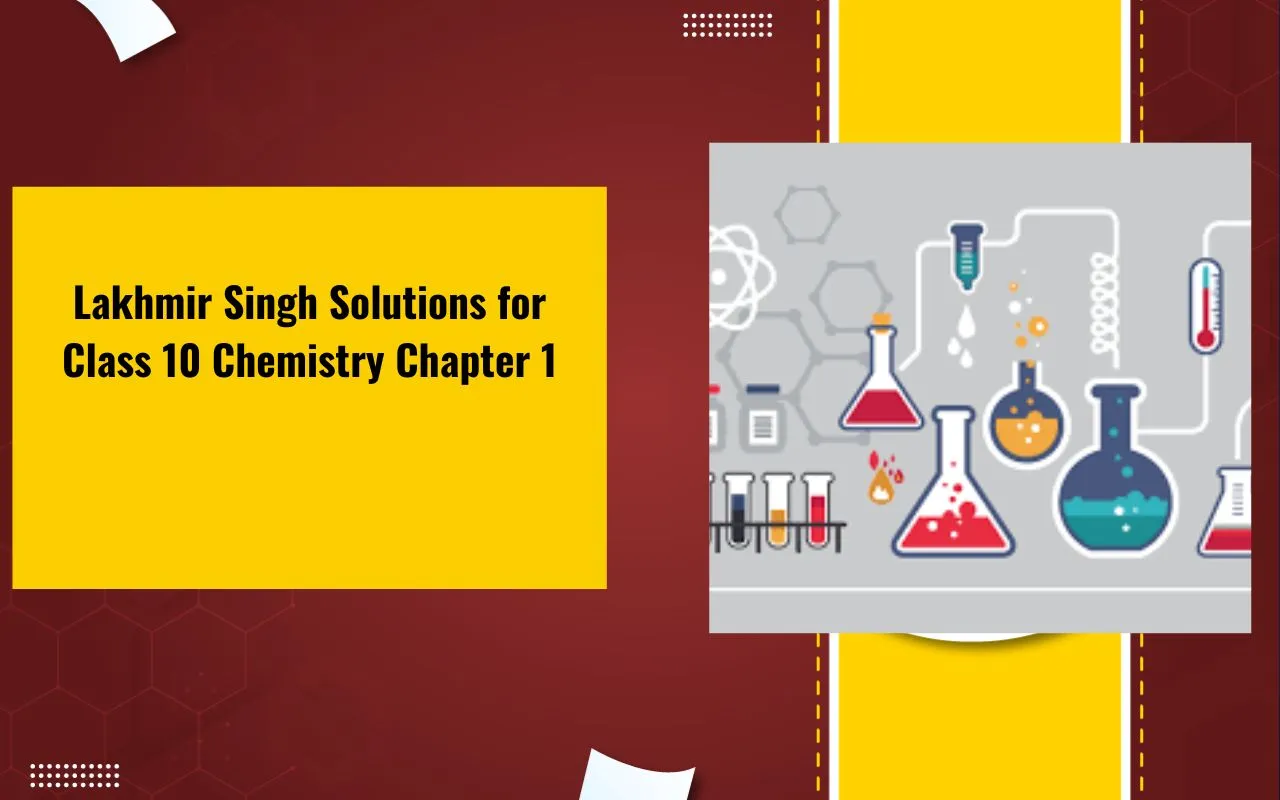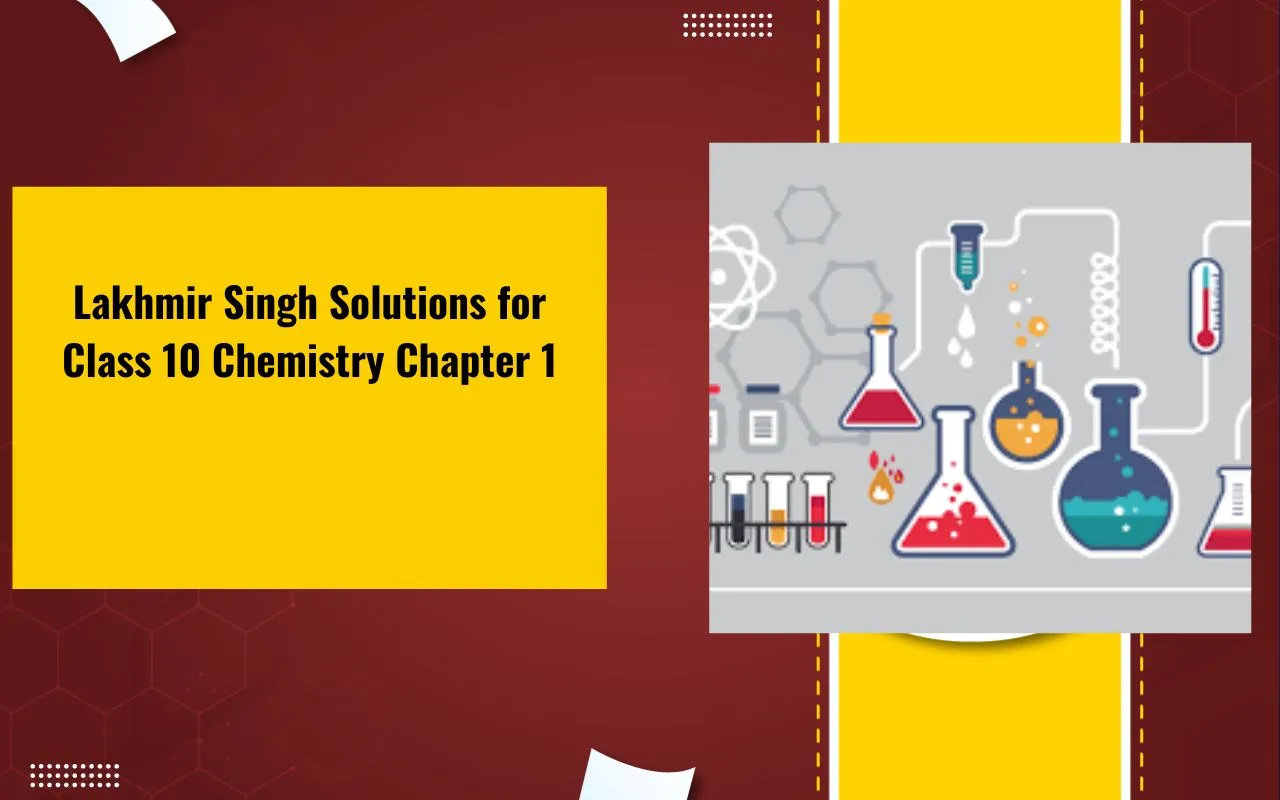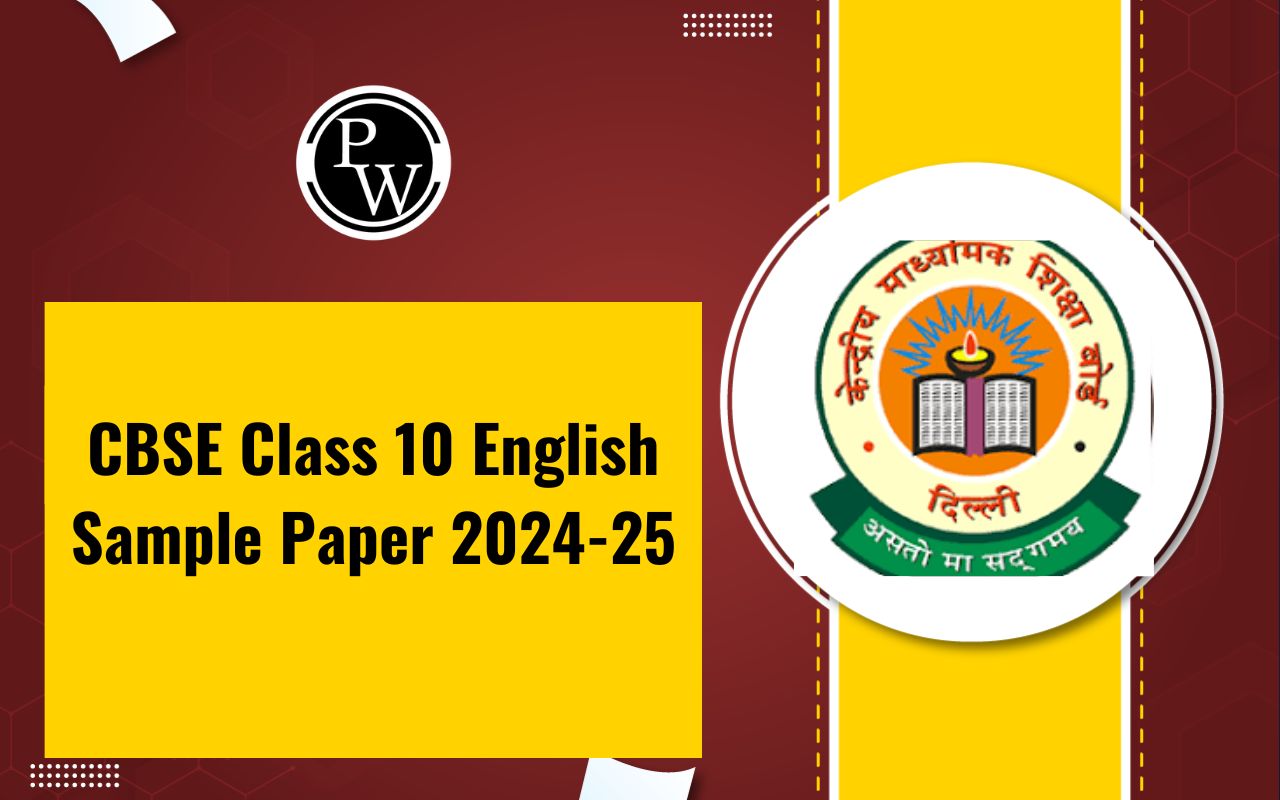

Lakhmir Singh Solutions for Class 10 Chemistry Chapter 1: Chemical reactions are processes where substances undergo chemical changes to form new substances with different properties. Lakhmir Singh Solutions for Class 10 Chemistry Chapter 1 Chemical Reactions and Equations provide comprehensive explanations and accurate answers to all the exercises in the textbook.
This chapter covers essential topics such as the definition of chemical reactions, their various types, writing chemical equations, and the importance of balancing them according to the law of conservation of mass.
The solutions are designed to help students clearly understand how to identify chemical reactions, represent them through balanced equations, and differentiate between different types of reactions.
Lakhmir Singh Solutions for Class 10 Chemistry Chapter 1 Chemical Reactions Overview
Class 10 Chemistry Chapter 1, titled “Chemical Reactions and Equations,” introduces students to the fundamental concepts of chemical reactions and how they are represented through chemical equations. The chapter begins by explaining what chemical reactions are, how to identify them, and the changes that occur during a reaction, such as change in state, color, temperature, or evolution of gas.
The concept of chemical equations is introduced, explaining how reactants are transformed into products and how to write equations accurately. It emphasizes the importance of balancing chemical equations to satisfy the law of conservation of mass, ensuring that the number of atoms of each element remains the same on both sides of the equation.
The chapter also explores different types of chemical reactions, including Combination, Decomposition, Displacement, Double Displacement, Oxidation, and Reduction reactions. Each type is explained with examples and practical applications to make learning more relatable.
Furthermore, the chapter highlights the significance of writing chemical equations in a balanced form and discusses the use of symbols, formulas, and conditions required for a reaction. With well-structured explanations and solved examples, the Lakhmir Singh Solutions make complex topics easier to understand, helping students build a strong foundation for future topics in chemistry.
Lakhmir Singh Solutions for Class 10 Chemistry Chapter 1 PDF
The Lakhmir Singh Solutions for Class 10 Chemistry Chapter 1 Chemical Reactions and Equations provide comprehensive answers to all the textbook questions, making it easier for students to understand the concepts of chemical reactions and how to balance chemical equations.
These solutions cover topics such as different types of chemical reactions, writing balanced equations, and the law of conservation of mass with detailed explanations and solved examples. The PDF link is available below for easy access and downloading, ensuring students can study and revise convenientl
Lakhmir Singh Solutions for Class 10 Chemistry Chapter 1 PDF
Lakhmir Singh Solutions for Class 10 Chemistry Chapter 1
Here are the Lakhmir Singh Solutions for Class 10 Chemistry Chapter 1 Chemical Reactions and Equations. With step-by-step explanations and simplified language, these solutions are an excellent resource for effective exam preparation and building a strong foundation in chemistry.
Page no: 18
In-text questions set 1
Very Short Answer Type Questions
1. Why is respiration considered an exothermic process?
Solution:
An exothermic reaction is a reaction in which the energy is liberated. In the process of respiration, energy is released and thus considered as an exothermic reaction
2. On what basis is a chemical equation balanced?
Solution:
A chemical equation is always balanced by comparing the number of atoms of each element on the reactant side as well as the product side. It is based on the Law of conservation of mass, i.e. number of atoms on the left-hand side should be equal to the right-hand side
3. What happens chemically when quicklime is added to water filled in a bucket?
Solution:
Quick lime is chemically calcium oxide. When it is added to water filled in a bucket, it forms calcium hydroxide (slaked lime) and reacts vigorously by releasing a large amount of heat which is an exothermic reaction.
4. Why should magnesium ribbon be cleaned before burning in the air?
Solution:
Magnesium ribbon is made up of pure magnesium metal, and it is highly reactive with oxygen which further leads to the oxidation of magnesium when it comes in contact with air. On the surface of the magnesium ribbon, it forms a layer of oxide and acts as a protective layer. So it is necessary to clean the magnesium ribbon before burning in the air
5. State whether the following statement is true or false:
A chemical equation can be balanced easily by altering the formula of a reactant or product.
Solution:
False
6. What is wrong with the following chemical equation?
Mg + O → MgO
Correct and balance it.
Solution:
Oxygen should be in molecular form, O2
2Mg + O2 → 2MgO
7. What does the symbol (aq) represent in a chemical equation?
Solution:
In a chemical equation, (aq) always represents for aqueous solution
8. Why is photosynthesis considered an endothermic reaction?
Solution:
Endothermic reactions are those in which heat is absorbed in the reaction. As we know that photosynthesis is a process that green plants and some other organisms use sunlight to synthesize food from carbon dioxide and water, which turns into oxygen and glucose. Plants absorb direct energy from the sun and thus consider photosynthesis as an endothermic reaction.
9. How will you indicate the following effects in a chemical equation?
(a) A solution made in water
(b) Exothermic reaction
(c) Endothermic reaction
Solution:
(a) The solution made in water can be indicated by the symbol (aq), which shows it is aqueous
(b) An exothermic reaction can be indicated by Heat, heat energy or energy on the product side
(c) An endothermic reaction can be indicated by Heat, heat energy or energy on the reactant side
10. Translate the following statements into chemical equations and then balance the equations:
(a) Hydrogen sulphide gas burns in the air to give water and sulphur dioxide.
(b) Phosphorus burns in oxygen to give phosphorus pentoxide.
(c) Carbon disulphate burns in the air to give carbon dioxide and sulphur dioxide.
(d) Aluminium metal replaces iron from ferric oxide, Fe2O3, giving aluminium oxide and iron.
(e) Barium chloride reacts with zinc sulphate to give zinc chloride and barium sulphate.
Solution:
(a) 2H2S + 3O2 → 2H2O + 2SO2
(b) P4 + 5O2 → 2P2O5
(c) CS2 + 3O2 → CO2 + 2SO2
(d) 2Al + Fe2O3 → Al2O3 + 2Fe
(e) BaCl2 + ZnSO4 → ZnCl2 + BaSO4
11. Write the balanced chemical equations for the following reactions:
(a) Calcium hydroxide + Carbon dioxide → Calcium carbonate + Water
(b) Aluminium + Copper chloride → Aluminium chloride + Copper
Solution:
(a) Ca(OH)2 + CO2 → CaCO3 + H2O
(b) 2Al + 3CuCl2 → 2AlCl3 + 3Cu
Page no: 19
12. Complete and balance the following equations:
(a) NaOH + ______ → Na2SO4 + H2O
(b) Ca(OH)2 + _______ → CaCO3 + H2O
Solutio:
(a) 2NaOH + H2SO4 → Na2SO4 + 2H2O
(b) Ca(OH)2 + CO2 → CaCO3 + H2O
13. Correct and balance the following equations:
(i) Ca + H2O → CaOH + H
(ii) N + H → NH3
Solution:
(i) Ca + 2H2O → Ca(OH)2 + H2
(ii) N2 + 3H2 →2NH3
14. Write complete balanced equations for the following reactions:
(a) Calcium (solid) + Water (liquid) →Calcium hydroxide (solution) + Hydrogen (gas)
(b) Sulphur dioxide (gas) + Oxygen (gas) → Sulphur trioxide (gas)
Solution:
(a) Ca (s) + 2H2O (l) → Ca(OH)2 (aq) + H2 (g)
(b) 2SO2 (g) + O2 (g) → 2SO3 (g)
15. Balance the following equations:
(i) Na + O2 → Na2O
(ii) H2O2→ H2O + O2
(iii) Mg(OH)2 + HCl → MgCl2 +H2O
(iv) Fe +O2 → Fe2O3
(v) Al(OH)3 → Al2O3 +H2O
(vi) NH3 + CuO → Cu +N2 +H2O
(vii) Al2(SO4)3 + NaOH → Al(OH)3 + Na2SO4
(viii) HNO3 +Ca(OH)2 → Ca(NO3)2
(ix) NaOH +H2SO4 → Na2SO4 +H2O
(x) BaCl2 + H2SO4 → BaSO4 +HCl
Solution:
(i) 4Na + O2 → 2Na2O
(ii) 2H2O2 → 2H2O + O2
(iii) Mg(OH)2 + 2HCl → MgCl2 + 2H2O.
(iv) 4Fe + 3O2 → 2Fe2O3
(v) 2Al(OH)3 → Al2O3 + 3H2O
(vi) 2NH3 + 3CuO → 3Cu + N2 + 3H2O
(vii) Al2(SO4)3 + 6NaOH → 2Al(OH)3 + 3Na2SO4
(viii) 2HNO3 + Ca(OH)2→ Ca(NO3)2 + 2H2O
(ix) 2NaOH + H2SO4 → Na2SO4 + 2H2O
(x) BaCl2 + H2SO4 → BaSO4 + 2HCl
16. Fill in the following blanks with suitable words:
(a) Chemical equations are balanced to satisfy the law of _______.
(b) A solution made in water is known as an ____ solution and is indicated by the symbol _______.
Solution:
(a) Conservation of mass
(b) Aqueous; (aq)
17. (a) Give one example of a chemical reaction.
(b) State two characteristics of the chemical reaction which takes place when dilute sulphuric acid is poured over zinc granules.
(c) Give two characteristics of the chemical reaction which occurs on adding potassium iodide solution to lead nitrate solution.
Solution:
(a)A chemical reaction results in new substances by undergoing certain reactions and rearrangements. There will be reactants on the left-hand side and products on the right-hand side. An example of a chemical reaction is
An example of combustion is methane + oxygen forms carbon dioxide and water. This can be written as a balanced symbol equation:
CH4 + 2O2 →CO2 + 2H2O
(b) When dilute sulphuric acid is poured over zinc granules, heat will liberate thus, the reaction becomes exothermic
Hydrogen gas is evolved, which burns with a sound
(c) 2KI (aq) + Pb(NO ) (aq) → PbI (↓) + 2 KNO (aq)
When solutions of lead nitrate and potassium iodide are mixed together, a yellow precipitate of lead iodide is formed. This is an example for Double Displacement Reaction.
18. (a) What is a chemical equation? Explain with the help of an example.
(b) Giving examples, state the difference between balanced and unbalanced chemical equations.
(c) Balance the following chemical equations:
(i) NH3 → N2 + H2
(ii) C +CO2→ CO
Solution:
(a) Chemical equations are the symbolic representation of chemical reactions in which the reactants and products are expressed in terms of chemical formulae. Reactant entities are given on the left side, and product entities are given on the right side of a chemical equation
Example: Zn + H2SO4→ZnSO4 + H2
(b) A balanced chemical equation is always energy and mass conservative, whereas an unbalanced chemical equation is neither energy nor mass conservative. A chemical equation can be written by balancing the total number of atoms of each element in reactants and products, while in unbalanced chemical equations, the total number of atoms of each element in reactants and products is not equal
Example: KClO3→KCl + 3O2 Unbalanced equation
2KCl03→2KCl + 3O2 Balanced equation
4.4
(c) (i) 2NH3 → N2 + 3H2
(ii) C +CO2→ 2CO
19. When hydrogen is passed over copper oxide, copper and steam are formed. Write a balanced equation for this reaction and state which of the chemicals are:
(i) Elements
(ii) Compounds
(iii) Reactants
(iv) Products
(v) Metals
(vi) Non-metals
Solution:
H2 + CuO→ Cu + H2O
(i) Elements: H2 and Cu
(ii) Compounds: CuO and H2O
(iii) Reactants: H2 and CuO
(iv) Products: Cu and H2O
(v) Metal: Cu
(vi) Non-metal: H2
20. (a) What are the various ways in which a chemical equation can be made more informative? Give examples to illustrate your answer.
(b) Write a balanced chemical equation from the following information:
An aqueous calcium hydroxide solution (lime water) reacts with carbon dioxide gas to produce a solid calcium carbonate precipitate and water.
Solution:
(a)Ca(OH)2 (aq)+ CO2 (g)—3000°C →CaCO3(s)+H2O(l)
A chemical equation can be informative by
1) The chemical states are indicated by (s) for solids, (l) for liquids and (g) for gases and (aq) for aqueous solution
2) Temperature is written on the above arrow
3) Arrow upwards shows compound or any gas formed escaped or liberated
4)Arrow downwards shows precipitated
5) Heat is written on the reactant side to indicate exothermic, and when on the written product side, it will be endothermic
b) Ca(OH)2 (aq) + CO2 (g) → CaCO3 (s) + H2O (l)
21. a) What is a balanced chemical equation? Why should chemical equations be balanced?
b) Aluminium burns in chlorine to form aluminium chloride (AlCl3). Write a balanced chemical equation for this reaction.
c) Potassium metal reacts with water to give potassium hydroxide and hydrogen gas. Write a balanced chemical equation for this reaction.
Solution:
(a) A chemical equation can be written by balancing the total number of atoms of each element in reactants and products. A chemical equation should be balanced so that it can follow the Law of conservation of mass.
(b) 2Al + 3Cl2 → 2AlCl3
(c) 2K + 2H2O → 2KOH + H2
Page no: 20
22. (a) Explain, with an example, how the physical states of the reactants and products can be shown in a chemical equation.
(b) Balance the following equation and add state symbols:
Zn + HCl → ZnCl2 + H2
(c) Convey the following information in the form of a balanced chemical equation:
“An aqueous solution of ferrous sulphate reacts with an aqueous solution of sodium hydroxide to form a precipitate of ferrous hydroxide, and sodium sulphate remains in solution.”
Solution:
(a) The physical state of the reactants and products in a chemical reaction can be shown by using the letters in the round brackets if it is solid, then (s) liquid (l) gas (g) and aqueous (aq)
Example: Ca(OH)2 (aq) + CO2 (g) → CaCO3 (s) + H2O (l)
(b) Zn (s) + 2HCl (aq) → ZnCl2 (aq) + H2 (g)
(c) FeSO4(aq) + 2NaOH (aq) → Fe(OH)2 (s) + Na2SO4 (aq)
23. Write any two observations in an activity which may suggest that a chemical reaction has taken place. Give an example in support of your answer
Solution:
(i) Change in temperature
When calcium oxide reacts vigorously with water to produce calcium hydroxide, a large amount of heat is evolved, and thus the temperature of the system increases hence it confirms that a chemical reaction has taken place.
(ii) Gas evolution
When calcium carbonate is heated, it decomposes into calcium oxide and carbon dioxide. Here carbon dioxide is a gas and thus confirms a chemical reaction
24. (a) Aluminium hydroxide reacts with sulphuric acid to form aluminium sulphate and water. Write a balanced equation for this reaction.
(b) Balance the following chemical equation:
MnO2 + HCl → MnCl2 + Cl2 + H2O
Solution:
(a) 2Al(OH)3 + 3H2SO4 → Al2(SO4)3 + 6H2O
(b) MnO2 + 4HCl → MnCl2 + Cl2 + 2H2O
25. Write the balanced chemical equations for the following reactions, and add the state symbols:
(a) Magnesium carbonate reacts with hydrochloric acid to produce magnesium chloride, carbon dioxide and water.
(b) Sodium hydroxide reacts with sulphuric acid to produce sodium sulphate and water.
Solution:
(a) MgCO3 (s) + 2HCl (aq) →MgCl2 (aq) + CO2 (g) + H2O (l)
(b) 2NaOH (aq) + H2SO4 (aq) →Na2SO4 (aq) + 2H2O (l)
26. Carbon monoxide reacts with hydrogen under certain conditions to form methanol (CH3OH). Write a balanced chemical equation for this reaction indicating the physical states of reactants and products as well as the conditions under which this reaction takes place.
Solution:
CO(g) + 2H2(g) → CH3OH
Pressure: 300atm
Temperature: 300℃
Catalyst: zinc oxide and chromium oxide
27. (a) Potassium chlorate (KClO3), on heating, forms potassium chloride and oxygen. Write a balanced equation for this reaction and indicate the evolution of gas. (b) Rewrite the following information in the form of a balanced chemical equation:
Magnesium burns in carbon dioxide to form magnesium oxide and carbon.
Solution:
(a) 2KClO3 (s) → 2KCl (s) + 3O2 (g)
(b) 2Mg + CO2 → 2MgO + C
28. (a) Substitute formulae for names and balance the following equations:
Calcium carbonate reacts with hydrochloric acid to produce calcium chloride, water and carbon dioxide gas.
(b) Write a balanced chemical equation with state symbols for the following reaction:
Sodium hydroxide solution reacts with hydrochloric acid solution to produce sodium chloride solution and water.
Solution:
(a) CaCO3 + 2HCl → CaCl2 + H2O + CO2
(b) NaOH (aq) + HCl (aq) → NaCl (aq) + H2O (l)
29. Ammonia reacts with oxygen to form nitrogen and water. Write a balanced chemical equation for this reaction. Add the state symbols for all the reactants and products.
Solution:
4NH3 (g) + 3O2 (g) → 2N2 (g) + 6H2O (l)
30. Write a balanced chemical equation for the process of photosynthesis, giving the physical states of all the substances involved and the conditions of the reaction.
Solution:
6CO2 (g) + 6H2O (l) → C6H12O6 (aq.) + 6O2 (g) in the presence of sunlight
Very Short Answer Type Questions
Page no: 45
1. What type of reaction is represented by the digestion of food in our body?
Solution:
A decomposition reaction is a reaction which is represented by the digestion of our body it is nothing but a chemical reaction where food that we are having is further broken down into digestible nutrients such as fats, proteins and carbohydrates, which are essential for the proper functioning of a human body
2. Name the various types of chemical reactions.
Solution:
There are many types of chemical reactions. Here are the names:
(i) Combination reactions.
(ii) Decomposition reaction.
(iii) Displacement reaction.
(iv) Double displacement reaction.
(v) Oxidation and reduction reactions.
3. Why does the colour of copper sulphate solution change when an iron nail is kept immersed in it?
Solution:
It is a displacement reaction. Copper sulphate solution changes its colour because the iron nail dipped in the solution is more reactive than copper sulphate, and it displaces the molecules. The copper gets deposited over the nail as the copper sulphate solution becomes iron sulfate solution, and colour changes from blue to green
4. Write the balanced chemical equation for the following reaction:
Zinc + Silver nitrate Zinc nitrate + Silver
Solution:
Zn + 2AgNO3 → Zn(NO3)2 + 2Ag
5. Which term is used to indicate the development of an unpleasant smell and taste in fat and oil-containing foods due to aerial oxidation (when they are kept exposed for a considerable time)?
Solution:
Rancidity is the term used, and this condition is produced by aerial oxidation of unsaturated fat present in food and other products. It is the incomplete oxidation of fats and oils when exposed to air, light or moisture
6. What is the general name of the chemicals which are added to fat and oil-containing foods to prevent the development of rancidity?
Solution:
Anti-oxidants are the chemicals which are added to fat and oil-containing foods to slow or delay the development of rancidity. Natural Anti-oxidants are ascorbic acid ad tocopherols, whereas synthetic anti-oxidants include Butylated hydroxyanisole (BHA) and Butylated hydroxytoluene (BHT)
7. State an important use of decomposition reactions.
Solution:
The decomposition of silver chloride into silver and chlorine by light is used in photography.
In the human body, this reaction helps in the digestion of food in the stomach.
The decomposition reaction is used in the manufacture of cement and gypsum.
This reaction is used in the process of welding.
8. What are anti-oxidants? Why are they added to fat and oil-containing foods?
Solution:
Anti-oxidants are the chemicals which are added to fat and oil-containing foods to slow or delay the development of rancidity. Natural Anti-oxidants are ascorbic acid ad tocopherols, whereas synthetic anti-oxidants include Butylated hydroxyanisole (BHA) and Butylated hydroxytoluene (BHT). Anti-oxidants can be nutrients as well as enzymes that are especially proteins that can assist in the chemical reaction and prevent development such as cancer, heart attack and many other chronic diseases
9. Explain why food products containing fats and oils (like potato chips) are packaged in nitrogen.
Solution:
The packet of chips or foods containing fats and oils is flushed with nitrogen. This is because nitrogen acts as an antioxidant, and this packaging is to prevent the food products from being oxidized. If we pack it with oxygen, it reacts and becomes rancid, and the smell and taste will change and will start to decay.
10. Give one example of a decomposition reaction which is carried out:
(a) With electricity
(b) By applying heat
Solution:
(a) When electricity is passed through acidified water, it decomposes into Hydrogen and oxygen gas
2H2 O → 2H2 + O2
(b) By applying heat, thermal decomposition takes place
2NaHCO3(s) → CO2(g) + H2O(g) + Na2CO3(s)
The heating of baking soda is an example
11. What type of chemical reaction is used to extract metals from their naturally occurring compounds like oxides or chlorides?
Solutions:
Decomposition reaction is used to extract several metals from their naturally occurring compounds like oxide and chloride
Example: 2NaCl → 2Na + Cl2
12. Name two anti-oxidants which are usually added to fat and oil-containing foods to prevent rancidity.
Solution:
Anti-oxidants are used as preservatives in fat-containing foods to slow up the development of rancidity due to oxidation
Butylated hydroxytoluene (BHT) and Butylated hydroxyanisole (BHA) can also be used as anti-oxidants with greater half-life than natural anti-oxidants.
13. Write one equation each for the decomposition reactions where energy is supplied in the form of (a) heat, (b) light, and (c) electricity.
Solution:
(a) Decomposition reaction when heat is supplied
2Pb(NO3)2→ 2PbO + 4NO2 + O2
(b) Decomposition reaction when light is supplied
2AgCl → 2Ag + Cl2
(c) Decomposition reaction where electricity is supplied
2H2O→ 2H2 + O2
Benefits of Solving Lakhmir Singh Solutions for Class 10 Chemistry Chapter 1
Clear Conceptual Understanding: Provides detailed explanations of chemical reactions, balanced equations, and different types of reactions, making learning simpler.
Step-by-Step Solutions: Provide a systematic approach to solving problems, especially balancing chemical equations accurately.
Exam-Focused Preparation: Covers all important topics and commonly asked questions in exams, ensuring thorough preparation.
Improved Problem-Solving Skills: Regular practice helps students enhance their analytical and problem-solving abilities.
Strong Foundation for Future Topics: Builds a solid base for advanced chemistry concepts, essential for higher studies.
Lakhmir Singh Solutions for Class 10 Chemistry Chapter 1 FAQs
What is covered in Lakhmir Singh Solutions for Class 10 Chemistry Chapter 1?
Why are Lakhmir Singh Solutions useful for Class 10 Chemistry Chapter 1?
How do Lakhmir Singh Solutions help in balancing chemical equations?
Are these solutions helpful for board exam preparation?













